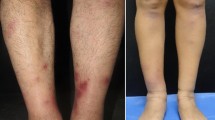Abstract
Pseudoxanthoma elasticum (PXE) is a multiorgan disorder affecting mainly the skin, the eyes, and the cardiovascular system. A 51-year-old woman was admitted to our clinic complaining of weakness and swelling of her legs for the past two years. She had a proteinuria of 7.29 g/24 h. Renal biopsy was performed, and the histological diagnosis was membranoproliferative glomerulonephritis. Four weeks later, she was admitted to the hospital due to pain in her left hand and necrosis in the fourth and fifth fingertips of the left hand. A skin biopsy was performed from the forearm and was reported as PXE. Herein, we present a case of membranoproliferative glomerulonephritis accompanying PXE.


Similar content being viewed by others
References
Hu X, Plomp AS, van Soest S et al (2003) Pseudoxanthoma Elasticum: A Clinical, Histopathological and Molecular Update. Surv Ophthalmol 48:424–438
Vanakker OM, Voet D, Petrovic M et al (2006) Visceral and testicular calcifications as part of the phenotype in pseudoxanthoma elasticum: ultrasound findings in Belgian patients and healthy carriers. Br J Radiol 79:221–225
Crespi G, Derchi LE, Saffioti S (1992) Sonographic detection of renal changes in pseudoxanthoma elasticum. Urol Radiol 13:223–225
Goodman RM, Smith EW, Paton D et al (1963) Pseudoxanthoma elasticum: A clinical and histopathological study. Medicine 42:297–304
Lebwohl M, Neldner K, Pope FM et al (1994) Classification of pseudoxanthoma elasticum: report of a consensus conference. J Am Acad Dermatol 30:103–107
Bergen AA, Plomp AS, Schuurman EJ et al (2000) Mutations in ABCC6 cause pseudoxanthoma elasticum. Nat Genet 25:228–231
Le Saux O, Urban Z, Tschuch C et al (2000) Mutations in a gene encoding an ABC transporter cause pseudoxanthoma elasticum. Nat Genet 25:223–227
Matsuzaki Y, Nakano A, Jiang QJ et al (2005) Tissue-specific expression of the ABCC6 gene. J Invest Dermatol. 125:900–905
Kool M, van der Linden M, de Haas M et al (1999) Expression of human MRP, a homologue of the multidrug resistance protein gene MRP1, in tissues and cancer cells. Cancer Res 59:175–182
Suarez MJ, Garcia JB, Orense M et al (1991) Sonographic aspects of pseudoxanthoma elasticum. Pediatr Radiol 21:538–539
Domjan JM, Dewbury KC (1996) Case report: multiple highly reflective foci in the renal parenchyma are not specific for pseudoxanthoma elasticum. Br J Radiol 69:871–872
Author information
Authors and Affiliations
Corresponding author
Rights and permissions
About this article
Cite this article
Altay, M., Turgut, F., Karakurt, F. et al. Membranoproliferative glomerulonephritis associated with pseudoxanthoma elasticum. Int Urol Nephrol 40, 1099–1101 (2008). https://doi.org/10.1007/s11255-007-9290-y
Received:
Accepted:
Published:
Issue Date:
DOI: https://doi.org/10.1007/s11255-007-9290-y




